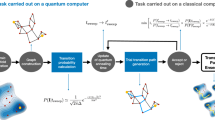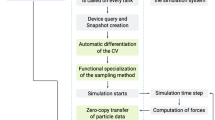Abstract
The original motivation to build a quantum computer came from Feynman1, who imagined a machine capable of simulating generic quantum mechanical systems—a task that is believed to be intractable for classical computers. Such a machine could have far-reaching applications in the simulation of many-body quantum physics in condensed-matter, chemical and high-energy systems. Part of Feynman’s challenge was met by Lloyd2, who showed how to approximately decompose the time evolution operator of interacting quantum particles into a short sequence of elementary gates, suitable for operation on a quantum computer. However, this left open the problem of how to simulate the equilibrium and static properties of quantum systems. This requires the preparation of ground and Gibbs states on a quantum computer. For classical systems, this problem is solved by the ubiquitous Metropolis algorithm3, a method that has basically acquired a monopoly on the simulation of interacting particles. Here we demonstrate how to implement a quantum version of the Metropolis algorithm. This algorithm permits sampling directly from the eigenstates of the Hamiltonian, and thus evades the sign problem present in classical simulations. A small-scale implementation of this algorithm should be achievable with today’s technology.
This is a preview of subscription content, access via your institution
Access options
Subscribe to this journal
Receive 51 print issues and online access
$199.00 per year
only $3.90 per issue
Buy this article
- Purchase on Springer Link
- Instant access to full article PDF
Prices may be subject to local taxes which are calculated during checkout




Similar content being viewed by others
References
Feynman, R. Simulating physics with computers. Int. J. Theor. Phys. 21, 467–488 (1982)
Lloyd, S. Universal quantum simulators. Science 273, 1073–1078 (1996)
Metropolis, N., Rosenbluth, A. W., Rosenbluth, M. N., Teller, A. H. & Teller, E. Equation of state calculation by fast computing machines. J. Chem. Phys. 21, 1087 (1953)
Durr, S. et al. Ab initio determination of light hadron masses. Science 322, 1224–1227 (2008)
Geman, S. & Geman, D. Stochastic relaxation, Gibbs distributions, and the Bayesian restoration of images. IEEE Trans. Pattern Anal. Mach. Intell. 6, 721–741 (1984)
Kirkpatrick, S., Gelatt, C. D. & Vecchi, M. P. Optimization by simulated annealing. Science 220, 671–680 (1983)
Suzuki, M. (ed.) Quantum Monte Carlo Methods in Equilibrium and Nonequilibrium Systems (Springer Ser. Solid-State Sci. 74, Springer, 1987)
Abrams, D. S. & Lloyd, S. Quantum algorithm providing exponential speed increase for finding eigenvalues and eigenvectors. Phys. Rev. Lett. 83, 5162–5165 (1999)
Aspuru-Guzik, A., Dutoi, A. D., Love, P. J. & Head-Gordon, M. Simulated quantum computation of molecular energies. Science 309, 1704–1707 (2005)
Verstraete, F., Wolf, M. M. & Cirac, J. I. Quantum computation and quantum-state engineering driven by dissipation. Nature Phys. 5, 633–636 (2009)
Farhi, E. et al. A quantum adiabatic evolution algorithm applied to random instances of an NP-complete problem. Science 292, 472–475 (2001)
Terhal, B. M. & DiVincenzo, D. P. Problem of equilibration and the computation of correlation functions on a quantum computer. Phys. Rev. A 61, 022301 (2000)
Binder, K. Monte Carlo and Molecular Dynamics Simulations in Polymer Science (Oxford Univ. Press, 1995)
Liu, J. & Luijten, E. Rejection-free geometric cluster algorithm for complex fluids. Phys. Rev. Lett. 92, 035504 (2004)
Swendsen, R. H. & Wang, J.-S. Nonuniversal critical dynamics in Monte Carlo simulations. Phys. Rev. Lett. 58, 86–88 (1987)
Evertz, H. G. The loop algorithm. Adv. Phys. 52, 1–66 (2003)
Kitaev, A. Y., Shen, A. H. & Vyalyi, M. N. Classical and Quantum Computation (American Mathematical Society, 2002)
Aharonov, D. & Naveh, T. Quantum NP - a survey. Preprint at 〈http://arxiv.org/abs/quant-ph/0210077〉 (2002)
Kitaev, A. Y. Quantum computations: algorithms and error correction. Russ. Math. Surv. 52, 1191–1249 (1997)
Cleve, R., Ekert, A., Macchiavello, C. & Mosca, M. Quantum algorithms revisited. Proc. R. Soc. Lond. A 454, 339–354 (1998)
Wootters, W. K. & Zurek, W. H. A single quantum cannot be cloned. Nature 299, 802–803 (1982)
Marriott, C. & Watrous, J. Quantum Arthur-Merlin games. Comput. Complex. 14, 122–152 (2005)
Oliveira, R. & Terhal, B. M. The complexity of quantum spin systems on a two-dimensional square lattice. Quant. Inf. Comp. 8, 900–924 (2008)
Aharonov, D., Gottesman, D., Irani, D. & Kempe, J. The power of quantum systems on a line. Commun. Math. Phys. 287, 41–65 (2009)
Schuch, N. & Verstraete, F. Computational complexity of interacting electrons and fundamental limitations of density functional theory. Nature Phys. 5, 732–735 (2009)
Jordan, P. & Wigner, E. Über das Paulische Äquivalenzverbot. Zeit. Phys. A 47, 631–651 (1928)
Abrams, D. S. & Lloyd, S. Simulation of many-body Fermi systems on a universal quantum computer. Phys. Rev. Lett. 79, 2586–2589 (1997)
Szegedy, M. in Proc. Annu. IEEE Symp. Found. Comput. Sci. 32–41 (IEEE, 2004)
Somma, R. D., Boixo, S., Barnum, H. & Knill, E. Quantum simulations of classical annealing processes. Phys. Rev. Lett. 101, 130504 (2008)
Poulin, D. & Wocjan, P. Sampling from the thermal quantum Gibbs state and evaluating partition functions with a quantum computer. Phys. Rev. Lett. 103, 220502 (2009)
Acknowledgements
We would like to thank S. Bravyi, C. Dellago, J. Kempe and H. Verschelde for discussions. Part of this work was done during a workshop at the Erwin Schrödinger Institute for Mathematical Physics. K.T. was supported by the FWF programme CoQuS. T.J.O. was supported, in part, by EPSRC. K.G.V. is supported by DFG FG 635. D.P. is partly funded by NSERC, MITACS and FQRNT. F.V. is supported by the FWF grants FoQuS and ViCoM, by the European grant QUEVADIS and by the ERC grant QUERG.
Author information
Authors and Affiliations
Contributions
This project was started by T.J.O. and F.V. five years ago and rejuvenated by an inspiring visit of K.G.V. with K.T. and F.V. in 2009. The connection to the QMA amplification scheme of Marriott and Watrous was made by D.P. at the Erwin Schrödinger Institute, and the project was finalized by K.T. and F.V. by proving quantum detailed balance.
Corresponding author
Ethics declarations
Competing interests
The authors declare no competing financial interests.
Supplementary information
Supplementary Information
The file contains Supplementary Text, additional references and Supplementary Figures 1-5 with legends. (PDF 2051 kb)
Rights and permissions
About this article
Cite this article
Temme, K., Osborne, T., Vollbrecht, K. et al. Quantum Metropolis sampling. Nature 471, 87–90 (2011). https://doi.org/10.1038/nature09770
Received:
Accepted:
Published:
Issue Date:
DOI: https://doi.org/10.1038/nature09770
This article is cited by
-
Fragmented imaginary-time evolution for early-stage quantum signal processors
Scientific Reports (2023)
-
Exploring finite temperature properties of materials with quantum computers
Scientific Reports (2023)
-
Szegedy Walk Unitaries for Quantum Maps
Communications in Mathematical Physics (2023)
-
Quantum Metropolis Solver: a quantum walks approach to optimization problems
Quantum Machine Intelligence (2023)
-
Sign-problem free quantum stochastic series expansion algorithm on a quantum computer
npj Quantum Information (2022)
Comments
By submitting a comment you agree to abide by our Terms and Community Guidelines. If you find something abusive or that does not comply with our terms or guidelines please flag it as inappropriate.



